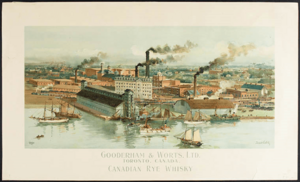Gooderham and Worts facts for kids
 |
|
| Industry | Distiller of alcoholic beverages |
|---|---|
| Fate | Merged with Hiram Walker & Sons Ltd. in 1926; sold to Allied Lyons in 1987 |
| Founded | 1869 |
| Headquarters | Toronto, Ontario, Canada |
|
Key people
|
|
Gooderham and Worts was a very important Canadian company. It was one of the biggest makers of alcoholic drinks in Canada. The company later joined with another large firm called Hiram Walker & Sons Ltd. in 1926.
The old factory buildings in Toronto were closed in the 1990s. But instead of tearing them down, people saved them! These buildings, which are from the 1860s, were turned into a fun area for arts and entertainment. It's now called the Distillery District. In 1998, the Gooderham and Worts Distillery was even named one of the National Historic Sites of Canada.
Contents
How Gooderham & Worts Started
The business was created by two relatives: James Worts and his brother-in-law, William Gooderham. James Worts had a mill in England before moving to Toronto in 1831. He built a large windmill near the Don River in Toronto.
William Gooderham joined him in Toronto in 1832. Their business grew well, processing grain from Ontario farmers. They then shipped the grain out through Toronto's port.
In 1834, James Worts sadly passed away. William Gooderham continued to run the business by himself. Since they had a lot of extra wheat, Gooderham decided to start making alcoholic drinks in 1837. This new part of the business quickly became very successful.
William Gooderham managed the company alone until 1845. Then, James Worts's oldest son, James Gooderham Worts, became a co-manager.
Growing the Distillery Business
In 1859, work began on a brand new factory complex. This is the area we now know as the Distillery District. It was built right on the waterfront. This made it easy to get goods to and from Toronto's main train lines.
In 1862, the factory's first full year, it produced about 700,000 gallons of spirits. This was a huge amount! It was a quarter of all the spirits made in Canada at that time.
Expansion and New Ventures
In the second half of the 1800s, Gooderham & Worts became one of Canada's most important industrial companies. Under the leadership of William's son, George Gooderham, the factory made over two million gallons of spirits each year. This was half of all the spirits produced in Canada! The factory grew bigger and became one of Toronto's largest employers.
The company didn't just make drinks. It also expanded into other businesses. They owned a big part of the Toronto and Nipissing Railway. This railway was important for bringing grain from farms north of Toronto. In 1892, the company built the Gooderham Building. This building is still a famous landmark in Toronto and was their main office.
Towards the end of the 1800s, the company's growth slowed down. More people in Canada started drinking beer and wine instead of whisky. Also, a movement to stop alcohol sales grew stronger. This was called the temperance movement. The Ontario Temperance Act in 1916 even banned selling alcohol in Ontario.
Gooderham & Worts survived by selling alcohol outside of Ontario. They also relied on their other businesses. For example, they made antifreeze, which was very important for cars and for the war effort.
Later Years and the Distillery District
In 1923, the company was sold to Harry C. Hatch. He paid $1.5 million for it. The company then sold a lot of its products to the United States during a time called Prohibition. During Prohibition, it was illegal to make or sell alcohol in the U.S.
In 1926, Harry C. Hatch bought Canada's second-largest company that made spirits, Hiram Walker & Sons Ltd.. This company made Canadian Club whisky. The two companies joined together and were called Hiram Walker-Gooderham & Worts Ltd. They kept making spirits at the Toronto factory, but production slowly decreased.
By 1990, the old factory buildings were closed because they were no longer modern enough. For several years, the empty site was used to film movies and commercials. Some famous movies filmed there include Tommy Boy, X-Men, The Hurricane, and Chicago.
Eventually, the site was transformed into the Distillery District. This area now includes the Young Centre for the Performing Arts, which opened in 2006. A group called Cityscape bought the complex in 2002. They were responsible for turning 24 old buildings into spaces for artists and art galleries.
Today, the Hiram Walker & Sons Distillery still makes Gooderham & Worts brand whiskies. However, they do it at their factory in Windsor, Ontario. The old Gooderham and Worts factory buildings in Toronto are now a popular historic and cultural spot.
The entire factory complex, with its 30 buildings, was named a National Historic Site of Canada in 1988. This was because it's a very important landmark. It shows how the Canadian distilling industry grew and changed over time.


